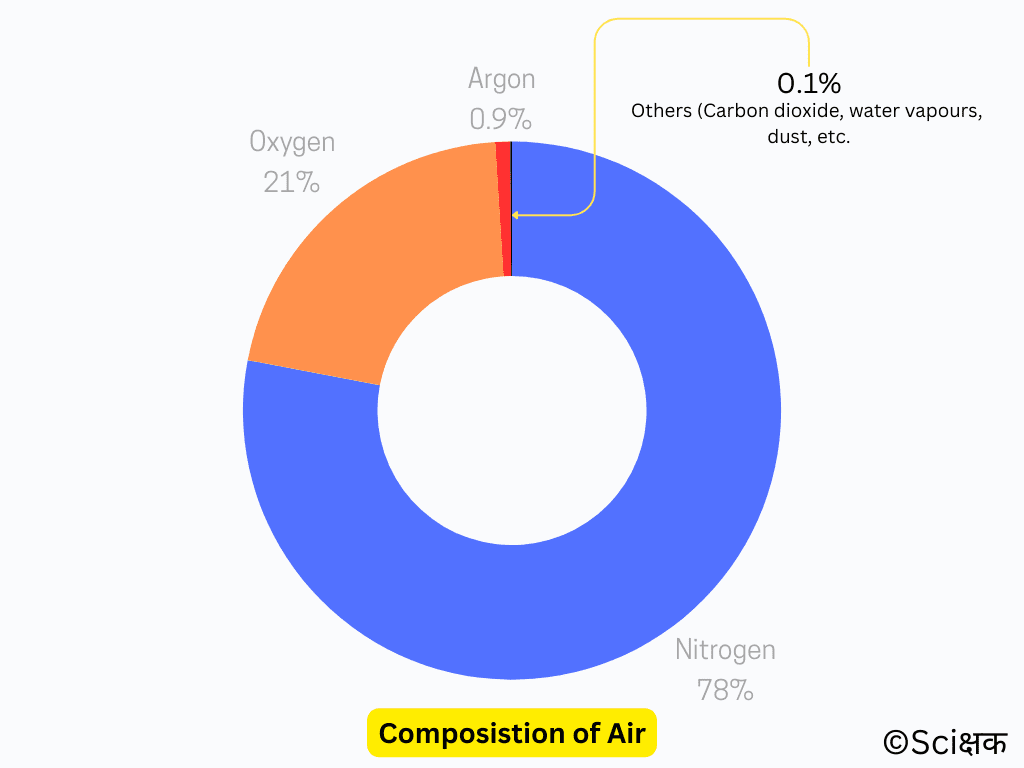Before starting with Class 6 Science Chapter 11 i.e. ‘Air Around Us’, I am hoping that you have completed the 10th chapter. If not, then you can go through its Notes and NCERT Exercise Solutions whose links have been provided below. ⤵️
Table of Content
Introduction
Has anyone seen the air? You have heard this question hundreds of times.
The answer is always the same, ‘No‘. But that doesn’t mean, it doesn’t exist.
We all can feel air just by placing our index finger on our upper lip and breathing out.
You will feel a gust of wind blowing out of your nostrils as you exhale.

You know it’s the wind (the moving air) that makes it possible for you to fly a kite, rotate a firki, winnow, etc.
Have you ever seen a weathercock? If not, then this is what one looks like.

It’s a device that shows the direction in which air is moving.
Is Air Present Everywhere Around Us?
We are surrounded by air. It is present everywhere around us, even in empty bottles.
Yes, you read it right, even in empty bottles. We can test for the presence of air in an empty bottle just by performing this one simple activity at home.
Activity to Confirm the Presence of Air in An Empty Bottle
- Take an empty water bottle and a bucket filled with water.
- Now dip the open mouth of the bottle into the bucket filled with water.
- Observe, whether the water enters the bottle or not.
- Now tilt the bottle slightly and again make the same observation.
- Do you see bubbles coming out of the bottle or hear any bubbly sound?
Observation & Inferences From The Activity
- The bottle wasn’t empty at all, it was filled with air when you turned it upside down.
- When the bottle was tilted the air was able to come out of the bottle in the form of air bubbles, and the empty space that was previously occupied by the air is now occupied by the water. This shows that air occupies space.
- Air is colourless, odourless and transparent.
Atmosphere
It is a blanket of air that surrounds our Earth and it extends up to thousands of kilometres from the Earth’s surface.

As we move up in the atmosphere the amount of air and temperature changes. And, that’s why mountaineers carry oxygen cylinders with them while climbing high mountains.
Composition of Air
Earlier people used to believe that air is just one substance but later people discovered that air is actually made up of various gases and other substances through experimentations.
Here are some of the major components of air:

1. Water Vapours
They are present in a very small quantity in the air, mainly due to the vaporisation of water.
They are the key elements in the water cycle.
The presence of water vapours in the air can easily be verified just by pouring some cold liquid in a jug (made up of metal or glass) and we will observe that the water vapours will start condensing as soon as they come in contact with the cold surface of the jug and form little water droplets.
2. Oxygen
It is the second largest part of the air.
Plants and animals use oxygen for respiration. And, it also supports burning.
The presence of oxygen in the air can easily be tested by a small activity.
Activity to Test for the Presence of Oxygen in the Air
- Take two candles of equal length and fix them on a table.
- Light up both candles and cover one of them with an inverted glass tumbler.
- Do both candles continue to burn off?
- No, the candle that was covered extinguished, whereas the other one continued burning.
- What can be the reason for this?
Inference
The candle was extinguished because the component inside of the glass tumbler, which supports burning, is limited. Most of the component is used up by the burning candles. However, the other candle is getting a continued supply of air. This component of air, which supports burning, is known as oxygen.
3. Nitrogen
This gas makes up the largest part of the air.
You will observe that gas is still present in the glass bottle even after the candle blew out (refer to the previous activity) after exhausting all the oxygen. This shows there is some component of air that is present in the tumbler that doesn’t support burning. Well, this major component of the air that doesn’t support burning is Nitrogen.
4. Carbon Dioxide
Have you ever felt suffocation in a closed room, if there is some material burning inside the room?
Well, that is due to the accumulation of Carbon dioxide and Carbon monoxide gases in the room.
Carbon dioxide makes up a very small portion of our air but it is really important for us and for plants as well.
- Plants use carbon dioxide to make their food by the process of photosynthesis.
- And Carbon dioxide keeps the Earth suitably warm.
Plants and animals consume oxygen and produce carbon dioxide. It is also produced from burning plant and animal matter as well. e.g. plant leaves, hairs, etc.
In recent years the amount of carbon dioxide in the air has increased and because of that the Earth has started to become more hotter and if it continues it would be lethal for all of us.
5. Dust and Smoke
Smoke is produced when we burn something in less amount (limited supply) of oxygen. It contains some harmful gases, dust and fuel particles. It is harmful for us to breathe in.
To keep smoke away from ourselves, we have installed long chimneys in our factories. But these long factory chimneys are spewing smoke for the flying birds.
Dust is always present in the air and its presence can easily be tested by some natural occurrences like,
Some tiny shining particles are moving in the beam of sunlight.
And, during winters you might have observed a similar beam of sunlight filter through the trees or windows of our room in which dust particles appear to dance merrily around!
The presence of dust particles in the air can vary from time to time and from place to place.
Our Nose and Dust in The Air
We inhale air through our nostrils while breathing in.
There are very fine hairs and mucus (slightly thick and sticky liquid) present inside our nose to prevent the dust particles from getting into our respiratory system.
That’s why it is advised to always breathe through nose, not with mouth.
Fun Fact: Oxygen and Nitrogen together make up 99% portion of air.
How Does Oxygen Become Available to Plants and Animals Living in Water and Soil?
Air is not only present on the surface of water but is also present in the soil and water as well.
Its presence can easily be tested by some simple activities:
Activity to Check for The Presence of Air in Water
- Pour some water into a metal container and put it on a stove.
- Start heating the water slowly.
- Before the water begins to boil, you will get to see some small bubbles forming inside the container.
- Well, these bubbles come from the air dissolved in water and when you heat the water they start to escape. And, if you continue heating, the water will boil and ultimately vaporise
Animals living in water use this dissolved air or oxygen for breathing and respiration. e.g. fish using their gills to take up the dissolved oxygen.
Activity to Check for The Presence of Air in Soil
- Take a small lump of soil into a beaker.
- Add water to the beaker and observe it.
- You will notice some small air bubbles coming out of the lump of soil due to the displacement of air by the water.
The organisms that live in soil (e.g. earthworms, etc.) and plant roots respire on this air or oxygen.
A lot of holes and burrows are formed in deep soil by the animals living in the soil. These burrows also make spaces available for air to move in and out of the soil. However, when it rains heavily, water fills up all the spaces occupied by the air in the soil. In this situation, animals living in the soil have to come
out for respiration. And that’s why you see earthworms crawling on the ground in the rainy season.
How is Oxygen In The Atmosphere Replaced?
Have you ever wondered, like most of the animals and plants need oxygen for their survival (respiration),
why hasn’t the oxygen been exhausted yet?
Who is refilling the oxygen in the atmosphere?
Well, the answer is very simple and the most important one.
It’s our best friends ‘Plants‘ who are refilling the atmospheric oxygen.
You may be wondering, that plant uses oxygen by themselves, so how come they are refilling it?
Well, we all know that plant make their food by the process of photosynthesis and in this process, they also produce a whole lot of oxygen as well. They only use a very small chunk of this produced oxygen for their respiration and release most of it back into the atmosphere for us to breathe and respire.
The balance of oxygen and carbon dioxide in the atmosphere is maintained through respiration in animals and plants and by photosynthesis in plants. This shows that animals and plants are interdependent on each other for their survival.
Various Uses of Air
We use air for various purposes. Some of the common uses of air are:
- In breathing and respiration.
- In the working of windmills (they are used to produce electricity, draw water out of tubewells, run flour mills, etc.)
- In transportation like aeroplanes, yachts, parachutes, gliders, hot air balloons, airships, etc.
- Birds and other animals can fly only because of air.
- In pollination and seed dispersal.
- In water cycle.
- It supports the burning of fuels e.g. wood, coal, petrol, etc.
- In photosynthesis.
- In hearing as well. Yes, it’s only because of the presence of air in our atmosphere that we can hear each other.
- In cooling of a room or building during summers, we use a flow of air generated from fans, coolers and air conditioners.
- In sports and recreational activities e.g. kite flying, skydiving, etc.
- In safety equipment like car airbags.
- In medicine and healthcare, e.g. oxygen therapy and ventilators use air to support patient breathing.
Conclusion
It is said that air, water and food are the basic needs for survival. And, to keep on surviving we need to conserve and not exploit these resources that Mother Nature has bestowed upon us. Over the past few years, the Earth’s temperature is rising and it is making our Earth more hotter than it was before. This all is happening because of the increased amount of carbon dioxide gas in the atmosphere, due to the excessive burning of fuels (like coal, wood, petroleum, etc) and deforestation (cutting down of the forests). To save ourselves and our upcoming generation and to preserve the beauty of Mother Earth we need to plant more trees to curb the impact of this increased carbon dioxide.
For this, you can start by planting a sapling(s) on your birthdays and taking care of it, till it becomes self-sufficient.
References & Credits
- Class 6 Science NCERT Textbook
- Image by Raquel Candia from Pixabay
- Image by brgfx on Freepik
- Image by Brigitte Werner from Pixabay
Thank You for Choosing Sciक्षक ❤️

